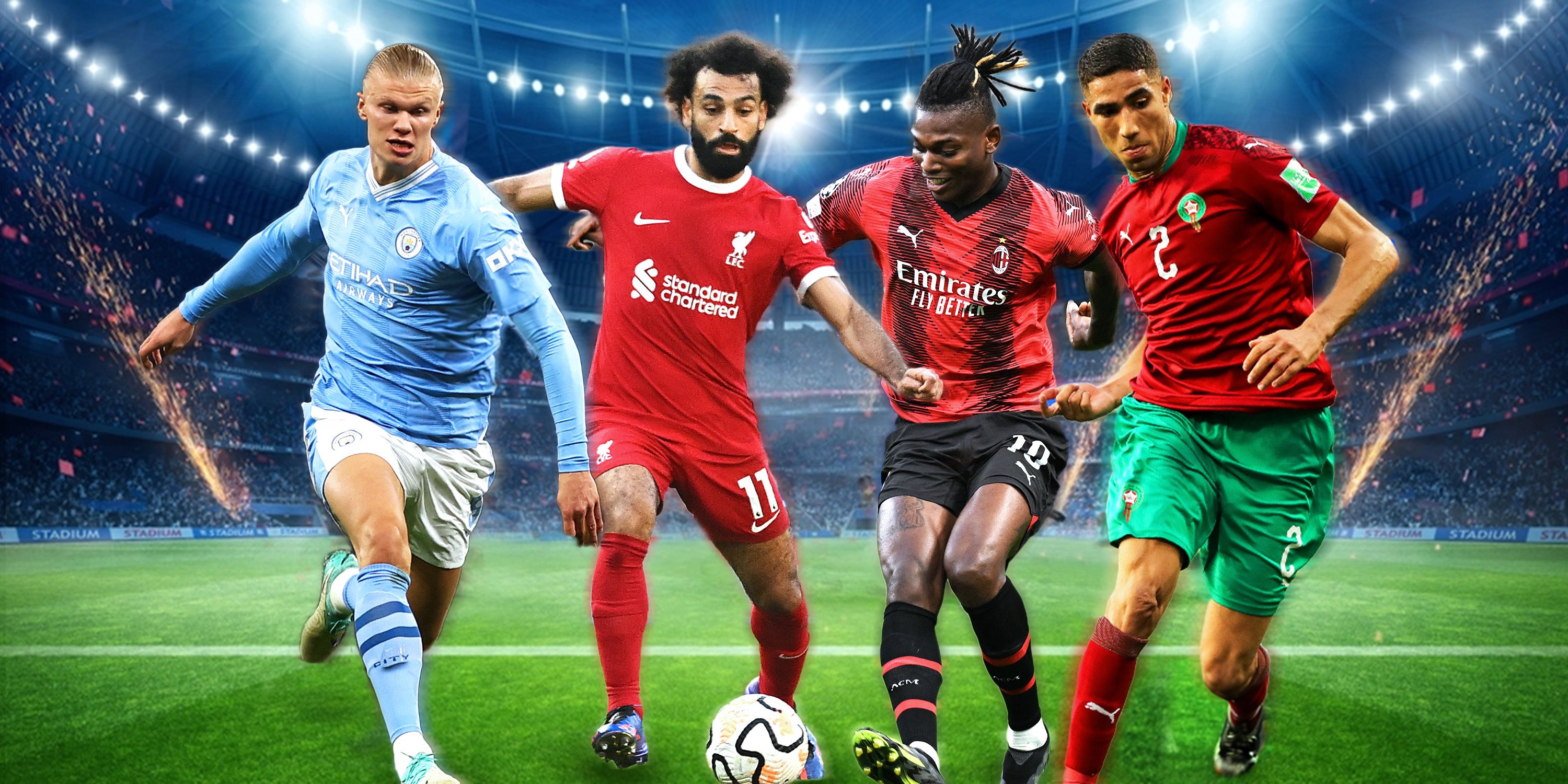
The Blazing Trail: Unpacking Speed Records and Elite Pace Across Football’s Top Leagues
In the electrifying realm of professional football, speed has always been a coveted attribute. From the explosive bursts of a winger leaving defenders in their wake to the lung-bursting recovery runs of a full-back, pace defines moments, dictates tactics, and often separates the good from the truly elite. In the modern game, however, speed is no longer just a raw physical gift; it’s a meticulously measured, strategically deployed, and increasingly indispensable weapon.
Thanks to advancements in tracking technology – from GPS vests to advanced optical tracking systems like Opta and Stats Perform – we now have unprecedented data on player movement. This allows us to not only identify the fastest individuals but also understand the nuances of speed: acceleration, sustained top speed, and the ability to maintain high intensity throughout a match.
This article delves into the fascinating world of football’s speed demons, exploring the fastest players across Europe’s top five leagues and beyond, examining the data, the tactical implications, and the ever-evolving role of pace in the beautiful game.
The Premier League: A Hotbed of High-Octane Pace
The English Premier League is renowned for its relentless intensity, end-to-end action, and physical demands. It’s a league where speed isn’t just an advantage; it’s often a prerequisite for survival and success. Consequently, the Premier League consistently features some of the world’s fastest footballers.
Historically, players like Thierry Henry, Michael Owen, and Gareth Bale (in his Tottenham days) set the benchmark. In the contemporary era, the names that frequently top the speed charts include:
- Kyle Walker (Manchester City): At over 30 years old, Walker continues to defy conventional wisdom, regularly clocking speeds exceeding 37 km/h. His incredible sustained pace and defensive recovery speed make him a unique asset for Pep Guardiola’s high-pressing system, allowing him to cover vast distances and shut down counter-attacks. He has reportedly hit speeds around 37.80 km/h, making him one of the fastest players ever recorded in the league.
- Mohamed Salah (Liverpool): While known more for his prolific goal-scoring, Salah’s speed is foundational to his game. His explosive acceleration and ability to hit high top speeds on the counter-attack are central to Liverpool’s direct style of play. He’s consistently among the fastest attackers, with top speeds often in the 36 km/h range.
- Marcus Rashford (Manchester United): Rashford’s raw pace and direct running style make him a constant threat. When given space, he can eat up ground incredibly quickly, often hitting speeds over 36 km/h. His ability to burst past defenders is crucial for United’s transitional play.
- Anthony Gordon (Newcastle United): The young winger has quickly established himself as a pace merchant, often recording some of the highest top speeds in individual matches. His directness and willingness to run in behind make him a nightmare for opposition full-backs.
- Mykhailo Mudryk (Chelsea): Though still adapting to the Premier League, Mudryk’s electrifying speed is undeniable. He’s been clocked at incredible speeds, showcasing the potential to be one of the league’s absolute fastest players once he fully settles.
The Premier League’s emphasis on quick transitions, intense pressing, and wide attacking play naturally favors players who can cover ground rapidly. Full-backs and wingers, in particular, need exceptional pace to contribute offensively and defensively.
La Liga: Technical Brilliance Meets Blistering Pace
While La Liga is often associated with technical wizardry and intricate passing, the Spanish top flight also boasts its fair share of speed merchants, particularly those who thrive in quick transitions and one-on-one duels.
- Vinicius Jr. (Real Madrid): Arguably the most electrifying player in La Liga, Vinicius Jr.’s pace is a cornerstone of his game. His ability to go from a standing start to top speed in a few strides is remarkable, allowing him to consistently beat defenders on the wing. He’s been clocked at speeds around 36.3 km/h, making him a nightmare for defenders attempting to contain him. His combination of raw speed, dribbling, and unpredictability makes him one of the most dangerous attackers in world football.
- Ronald Araujo (FC Barcelona): It’s not just attackers who are fast. Araujo, a central defender, possesses surprising top-end speed and acceleration for his position. This allows him to cover for teammates, make crucial recovery tackles, and defend high lines effectively. His pace often registers above 34 km/h, which is exceptional for a centre-back.
- Alejandro Balde (FC Barcelona): The young left-back has burst onto the scene with his incredible attacking runs and defensive recovery. His pace down the flank is a key component of Barcelona’s attacking width.
La Liga’s tactical landscape, while valuing possession, also highly prizes players who can exploit space created by intricate passing sequences or launch devastating counter-attacks, making speed a vital component of its top teams.
Bundesliga: The Home of Gegenpressing and Galactic Speed
The Bundesliga is perhaps the most direct and vertically oriented of the major European leagues, famous for its high-pressing Gegenpressing style and rapid transitions. This tactical approach naturally demands players with immense stamina and, crucially, blistering pace.
- Alphonso Davies (Bayern Munich): The Canadian full-back is arguably the poster child for speed in modern football. Davies’ top speed is simply astonishing, allowing him to patrol the entire left flank with ease. He has reportedly hit speeds of 36.51 km/h in a Bundesliga match, showcasing his ability to outpace almost any opponent. His unique blend of defensive solidity and attacking explosiveness makes him one of the world’s most dynamic players.
- Jeremie Frimpong (Bayer Leverkusen): Another incredibly fast full-back/wing-back, Frimpong’s acceleration and sustained pace are vital to Leverkusen’s attacking play. He consistently makes lung-bursting runs down the right flank, creating chances and stretching defenses. His top speeds often exceed 36 km/h.
- Karim Adeyemi (Borussia Dortmund): The young German forward is known for his explosive bursts and ability to run in behind defenses. He’s one of the quickest players in the league over short distances, with recorded speeds around 36.1 km/h.
- Kingsley Coman (Bayern Munich): Though sometimes overshadowed by other stars, Coman’s direct running and rapid pace are a constant threat on the wing for Bayern, contributing significantly to their attacking prowess.
The Bundesliga’s emphasis on high-octane football means that every team, from the top to the bottom, values pace as a key attribute for its wingers, full-backs, and even some central midfielders who need to cover ground quickly.
Ligue 1: The Launchpad for Speedsters
France’s Ligue 1 has long been a breeding ground for exceptionally talented and fast footballers, with many making their names there before moving to other top leagues. The league’s tactical diversity, often featuring direct play and open spaces, allows speedsters to truly shine.
- Kylian Mbappé (Paris Saint-Germain): Unquestionably one of the fastest players in football history, Mbappé’s combination of acceleration, top speed, and agility is unparalleled. He seems to glide across the pitch, leaving defenders in his wake with effortless ease. While official league-wide top speeds can be elusive, Mbappé has been clocked in individual sprints well over 38 km/h (with the ball at his feet), and reportedly hit 36 km/h in the Champions League, making him a true outlier. His ability to change direction at full pace is what truly sets him apart.
- Achraf Hakimi (Paris Saint-Germain): The Moroccan right-back is another lightning-fast player for PSG, crucial for their attacking width and defensive recovery. His ability to bomb up and down the flank at incredible speeds makes him one of the best attacking full-backs in the world.
- Ousmane Dembélé (formerly PSG/Barcelona): Before his move to PSG, Dembélé consistently demonstrated his blistering pace and ambidextrous dribbling, capable of hitting high speeds on either wing.
Ligue 1’s tactical landscape often provides more space for attackers to run into, making it an ideal environment for players to showcase and hone their raw pace.
Serie A: From Catenaccio to Counter-Attacking Pace
Historically, Serie A was known for its tactical rigidity and defensive prowess (Catenaccio). However, in recent years, the league has evolved, embracing more dynamic, attacking football, with pace becoming an increasingly vital asset, particularly in counter-attacking scenarios.
- Rafael Leão (AC Milan): The Portuguese forward is arguably the most electrifying player in Serie A. His incredible blend of physical power, dribbling ability, and explosive speed makes him a devastating force. Leão can cover vast distances with the ball at his feet, often hitting speeds well over 36 km/h, leaving multiple defenders in his wake. He is central to AC Milan’s attacking identity.
- Theo Hernández (AC Milan): Like his teammate Leão, Theo Hernández is a physical phenomenon. The French left-back combines strength with blistering pace, making him a constant threat on the overlap and a vital component of Milan’s counter-attacks. His top speeds are consistently among the highest for full-backs in Europe, often exceeding 35 km/h.
- Ademola Lookman (Atalanta): The Nigerian forward has brought his pace and directness to Serie A, proving to be a handful for defenders with his ability to run in behind and his quick bursts of speed.
Serie A teams increasingly rely on quick transitions and athletic full-backs and wingers to exploit spaces, making players with high top speeds and excellent acceleration highly sought after.
Beyond the Big Five: Global Pace Setters
While Europe’s top five leagues garner the most attention, blistering pace is a global phenomenon. Players in leagues like the MLS, Liga MX, Eredivisie, and others also display incredible athletic feats.
- Alphonso Davies’ journey from the Vancouver Whitecaps in MLS to Bayern Munich is a testament to the speed talent that can emerge from non-European leagues.
- The Eredivisie in the Netherlands, known for its attacking football and youth development, consistently produces fast wingers and full-backs.
- Liga MX in Mexico and the Brasileirão in Brazil also feature numerous players with exceptional pace, crucial in their often high-tempo, end-to-end matches.
The Science of Speed: More Than Just Raw Talent
What makes these players so fast? It’s a complex interplay of genetics, training, and biomechanics:
- Genetics: Some individuals are simply born with a higher proportion of fast-twitch muscle fibers, which are responsible for explosive power and speed.
- Training: Elite athletes undergo rigorous training regimes that focus on:
- Plyometrics: Exercises that improve explosive power (e.g., box jumps, bounds).
- Sprint Training: Specific drills to improve acceleration, maximum velocity, and speed endurance.
- Strength Training: Building core and leg strength to generate more force and prevent injuries.
- Agility and Change of Direction Drills: Crucial for football, where straight-line speed is rarely sufficient.
- Biomechanics: Efficient running form, stride length, and stride frequency all contribute to optimal speed. Coaches and sports scientists work to refine these aspects.
- Recovery and Nutrition: Proper rest, hydration, and diet are essential for muscle repair and peak performance, allowing players to maintain their speed throughout a grueling season.
The Tactical Impact of Speed
Speed is no longer just an individual highlight reel moment; it’s a fundamental tactical tool:
- Offensive Weapon:
- Breaking Lines: Fast players can run in behind defenses, creating space and goal-scoring opportunities.
- Stretching Defenses: Their presence forces defenders to drop deeper, opening up space in midfield.
- Counter-Attacking: The ability to transition from defense to attack rapidly is devastating, particularly with pacey forwards and wing-backs.
- Defensive Asset:
- Recovery Runs: Fast defenders and midfielders can track back quickly to prevent counter-attacks.
- Pressing: High-intensity pressing schemes rely on players with explosive acceleration to close down opponents quickly.
- Covering Space: Pace allows players to cover large areas of the pitch, both defensively and in supporting attacks.
Beyond Top Speed: Acceleration and Football IQ
While top speed metrics are exciting, it’s crucial to understand that raw maximum velocity isn’t the only, or even always the most important, measure of a player’s pace in football.
- Acceleration: The ability to reach top speed quickly from a standing start or low speed is often more vital in football than sustained top speed. Most actions in a game involve short, sharp bursts of acceleration rather than long, continuous sprints. Players like Erling Haaland, while not necessarily clocking the absolute highest top speeds, possess phenomenal acceleration that allows them to get away from defenders in tight spaces.
- Speed with the Ball: The ability to maintain high speed while dribbling or carrying the ball is a rare and invaluable skill. Kylian Mbappé and Vinicius Jr. excel in this regard, making them incredibly difficult to dispossess.
- Football IQ: Knowing when and where to make a run, how to exploit space, and how to combine speed with dribbling or passing is what truly elevates a fast player from merely athletic to world-class.
Conclusion: The Enduring Allure of Pace
Speed in football has evolved from a raw, eye-catching attribute to a deeply integrated component of modern tactics and player development. The data now available allows us to appreciate the nuances of pace, from the sustained efforts of Kyle Walker to the explosive bursts of Kylian Mbappé and Vinicius Jr.
As the game continues to demand higher intensities and more dynamic play, the value of speed will only increase. Whether it’s to unlock a stubborn defense, shut down a counter-attack, or simply thrill the crowd with a breathtaking sprint, the fastest players across the world’s elite leagues will continue to be among the most exciting and impactful figures in the beautiful game. Their blazing trails are not just a testament to physical prowess, but to the relentless evolution of football itself.



